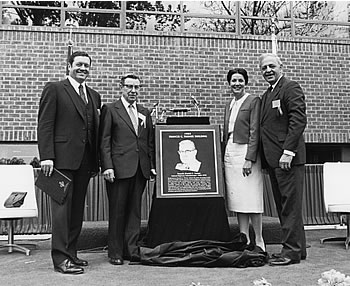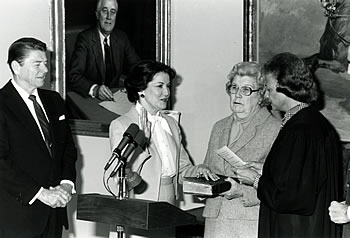In Memory of Ronald Reagan
By Richard Weingroff
As the country mourned the death of former President Ronald Reagan on June 5, 2004, the FHWA recalled his role in our program.
President Reagan's choice as Federal Highway Administrator was former Texas Highway Commissioner Ray Barnhart who would serve as Administrator longer than any other person to hold that title (1981-1987). Although his many accomplishments benefited the transportation community and the nation, Barnhart is remembered within the FHWA for his strong leadership, his determined advocacy, and his fine-tuned communication skills. He also had a common touch that allowed him to connect with employees at all levels. Barnhart was recently inducted into the Texas Transportation Hall of Fame.
A proponent of "New Federalism," President Reagan wanted to adjust the roles of Federal and State governments to give the States greater authority. His State of the Union Address in 1982 proposed to turn back most of the Federal-aid highway program, except the Interstate System, and all transit programs to the States. However, the final bill, the Surface Transportation Assistance Act (STAA) of 1982, continued strong Federal involvement in both programs. Responding to the growing infrastructure crisis, the legislation increased the gasoline tax by a nickel, the first increase since 1959.

Administrator Barnhart and Transportation Secretary Drew Lewis secured one of their most important victories when President Reagan signed the STAA on January 6, 1983. Despite his strong views on cutting taxes, the President signed the increase because, as he said during the signing ceremony:
As this bill becomes law, America ends a period of decline in her vast and world-famous transportation system.
As the President predicted, the increase allowed the Nation to get ahead of the pavement and bridge deterioration curve by the mid-1980s. The legislation also devoted one cent of each nickel to establish a Transit Account in the Highway Trust Fund, still a primary source of funding for transit improvements-now receiving two cents of the gas tax.
President Reagan appointed Elizabeth Dole to succeed Secretary Lewis in 1983. The first woman to hold the post, Secretary Dole made safety one of her signature issues. During her tenure, President Reagan signed the Commercial Motor Vehicle Safety Act on July 27, 1986, which gave the FHWA new tools to improve safety, including the requirement that commercial operators have a single commercial driver's license based on uniform standards for testing drivers. She also joined Administrator Barnhart, Deputy Administrator Les Lamm, and other FHWA officials on May 5, 1983, in dedicating the $6.5 million Francis C. Turner Building in honor of the former Federal Highway Administrator at the renamed Turner-Fairbank Highway Research Center. Today, Mrs. Dole represents North Carolina in the United States Senate.

In celebrating the 30th anniversary of the National System of Interstate and Defense Highways, as it was still called at the time, President Reagan declared National Interstate Highway Day on June 26, 1986. His proclamation hailed the Interstate System as "the world's largest and most successful transportation and public works project."
The Reagan Administration made several attempts, without success, to redefine the Federal and State roles. One was the proposed Federalism Block Grant Highway Act of 1983, which would have given States a choice of retaining the existing core program or switching to a block grant for most core funding categories. The Administration also proposed a block grant approach when the Federal-aid highway and transit programs came up for reauthorization in 1986. Congress again rejected the approach. The Surface Transportation and Uniform Relocation Assistance Act of 1987 (STURAA) retained the basic structure of the Federal-aid highway and transit programs.
For a variety of reasons, President Reagan vetoed the bill, setting off one of the most unusual legislative battles in the history of the Federal-aid highway program and, as contemporary accounts made clear, of the Reagan Administration. The story of the veto battle is told in the following account:
President Ronald Reagan and the Surface Transportation and Uniform Relocation Assistance Act of 1987
The Surface Transportation and Uniform Relocation Assistance Act of 1987 (STURAA) was widely seen in Congress and the transportation community as the last authorization bill of the Interstate era. The Interstate System was 97.5 percent open to traffic (41,759 miles of the 42,797 designated Interstate miles) and it was not clear if the few remaining segments, each controversial within its community, could be built.
The Interstate era had begun with consensus across the spectrum of transportation interests and political shadings, on building the Interstate System. After more than 30 years of accomplishment and controversy, that consensus had disappeared. Transit had gone from a private industry to a public utility, with its own demands for Federal funding. The environmental movement, which had not entered the public consciousness in 1956, had created new national commitments that challenged the builders of the Interstate System. State and city officials had conflicting transportation goals. Politically, the Federal role in transportation, which had enjoyed bipartisan support for decades, had been challenged by President Ronald Reagan. He favored a New Federalism under which activities he believed to be State responsibilities under the Constitution would be devolved to the States.

Even enactment of STURAA reflected the growing fragmentation. President Reagan had vetoed the bill on March 27, citing a variety of problems, including funding levels that exceeded his request by $10 billion. He was especially concerned about the 121 "demonstration projects" in the bill. Members of Congress who wanted funds for a project in their State had adopted the practice of inventing a concept it would "demonstrate" as if it were part of an important research initiative. (Under this idea, for example, funding for two parking lots became a demonstration of "methods of facilitating the transfer of passengers between different modes of transportation.") To Reagan, they were wasteful. He told the press, "I haven't seen this much lard since I handed out blue ribbons at the Iowa State Fair."
Still damaged by the "Iran-Contra" controversy that had struck his Administration, Reagan and his advisors saw the veto battle as a way to demonstrate he would be more than a caretaker in his last 21 months in office. The House voted decisively to overturn his veto, but it was close in the Senate. Very close. The President needed one-third of the Senators plus one to vote to sustain his veto.
On April 1, he prevailed in an initial roll call ballot by one vote. It was cast by Terry Sanford (D-NC), a 69-year old freshman in the United States Senate. Sanford had promised State officials he would oppose STURAA because he agreed with their assessment that North Carolina did not receive enough funds under its formulas. As a result, he had been the only Democratic Senator to vote against the bill when it initially passed the Senate. After 99 Senators had cast their vote, his would decide the issue. Sanford was surrounded by Democratic Senators urging him to vote with them to overturn the veto, and one Republican, Senator Alan K. Simpson (WY), who urged him to vote to sustain the veto as a measure of support for the President. Confused by Senate rules, Sanford initially voted "present," thinking he could in this way sustain the veto without voting against his party. Under Senate rules, the reverse was true. Quickly realizing his mistake, Sanford changed his response to "nay" a few minutes later. The veto was sustained, theoretically killing STURAA.
Deft parliamentary maneuvering by Majority Leader Robert C. Byrd (D-WV) forced a second vote on April 2. Under pressure from Senate Democrats and his State's Representatives who had voted to override, Senator Sanford announced he would vote with them to overturn the veto. He was, he said, "doing my duty as I see it." With all 54 Senate Democrats and 13 Republicans in favor of overturning the veto, the President needed just one of the 13 Republicans to switch for the veto to be sustained. He took the unprecedented step of going to the Capitol to lobby the Republicans personally. As Time magazine said of his meeting with the 46 Republican Senators: "Reagan uttered six words that Presidents use sparingly at best: 'I beg you for your vote.' The 13 Republicans felt the pressure."
They wanted to support their President, but not on a bill that was popular back home-bringing with it not only needed highway and transit funding but a provision that would allow the States to increase speeds to 65 mph on rural Interstate highways. Referring to the 13 Republican Senators who had voted to override the veto, Senator John McCain (R-AZ) said, "You could almost see them squirming."
Although the Republican Senators desperately wanted to support President Reagan, they simply could not do so on this vote. In the end, all 13 Republicans and Senator Sanford voted to override the President's veto in a 67-33 vote that made the STURAA the law of the land by one vote on April 2.
The first -and only -veto of a "highway" bill in the 20th century. Widespread media exposed alleged "pork" in the bill. This was a surface transportation bill at the center of a political firestorm. A President begged for votes from his own party. Such high stakes were not usually associated with transportation bills. In short, the consensus forged in 1956 had clearly been shattered.
And so had Senator Sanford's political career. Sanford, a distinguished former Governor of North Carolina (1961-1965), had been President of Duke University (1969 to 1985, and President Emeritus, 1985 to 1998) and a Democratic Presidential candidate in 1972 and in 1976. But after the STURAA veto battle, he never overcame the image of confusion surrounding his three votes in 24 hours. According to political observers, he spent the remainder of his lone term in the Senate living down the episode that earned him the nickname "Turnaround Terry." In 1991, he voted in favor of ISTEA. Senator Sanford was defeated for reelection in 1992 by Rep. Lauch Faircloth. Sanford died on April 18, 1998.
